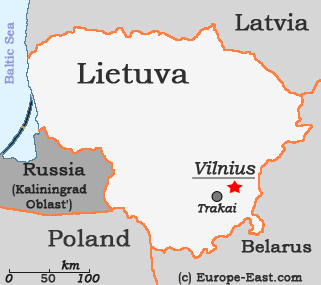Official name
Lietuvos Respublika (Republic of Lithuania), abbrevated Lietuva (Lithuania). There are several theories about the origin of the name - one says it might derive from the Latin word Litus, which means "shore".
From 1940 to 1941 and again from 1944 to 1991, Lithuania was one of the 15 Soviet republics and known as Литовская ССР (Litovskaya SSR, Socialist Soviet Republic Lithuania) at that time.
Area & Population

| ||
| Clickable map of Lithuania |
65,301 km². This makes Lithuania only slightly bigger than neighbouring →Latvia or West Virginia and a little bit smaller than the Benelux zone.
Lithuania has around 3.61 million inhabitants (as of 2004) and it's shrinking - the reason for this is the extraordinarily low birth rate.
Around 80.6% of the population are Lithuanians, Russians add up to 8.7% only, which is very low compared to other Ex-Soviet republics. Another 7% are Poles. Additionally, there are Belarusian, Ukrainian and other minorities - such as Armenians, →Karaim and - since very recently - Vietnamese (as of 2002).
Religion
For historical reasons, the majority of believers belongs to the Roman-Catholic faith. Furthermore, there are Protestants, Orthodox, Babtists and Jewish minorities.
Time zone
Eastern European time: UTC +02 hrs, with daylight-saving time (+1 hour) in summer.
Lithuanian. This language belongs to the Baltic branch of the large Indo-European language family - only few other languages belong to the same branch, namely →Latvian and the already extinct languages Prussian and Livonian.
Lithuanian could be much closer to a Proto-Indo-European language than any other language of the same family. This means that many old grammatical patterns - some of them resembling Latin - and certain common words seemed to have survived in Lithuanian. However, countless loan words, mostly from the German, Polish and nowadays English language, have infiltrated Lithuanian. Almost all of these words have been rendered so to make their reading consistent - even names are being altered and rarely keep their original spelling.
Nouns are written in small letters (which is different to a number of languages spoken in the wider area) and have two sexes. Articles aren't used - instead, endings make clear what kind of noun it is. Lithuanian grammar knows 7 cases (Russian has 6, German 4). One grammatical oddity is the fact that the past tense can be divided into a singular past tense and a multiple past tense.
Lithuanian uses the Latin alphabet, but there is a number of diacritic symbols to take into account the Lithuanian pronunciation. Some vowels feature a dot above or a comma below (the latter is known as "ogonek", mostly marking a long vowel). Several consonants come with a caron (wedge or inverted hat) to be used for sibilants. The following list shows vowels that do not exist in English or have a different spelling from Latin pronunciation
- Ą (ą) : Long [A] as the [ ar ] [cart]. The regular [ a ] is either short or long.
- Ę (ę) Long, open [ e ], similar to the [ a ] in [ care ] but longer. The regular [ e ] can be either long or short.
- C (c) Always pronounced as the [ ts ] in [ tsar ]
- Č (č) : As the [ tch ] in [ catch ].
- ch As the [ kh ] in Russian names such as [ kolkhoz ].
- Ė (ė) Long, closed [ e ], similar to the first [ e ] in [ there ].
- Į (į) Long [ i ] as the [ ee ] in [ bee ]. The regular [ i ] is always short as the [ i ] in [ middle ].
- Y (y) Also a stretched [ i ] (ee), similar to [ Į ].
- O (o) Mostly stretched, open [ o ] as in [go]. However, in loan words often short.
- Š (š) Similar to the [ sh ] in [ wash ].
- Ų (ų) Always stretched, as the [ oo ] in [ boot ]. The regular [ u ] is the short version
- Ū (ū) Almost identical to the [ ų ].
- Ž (ž) Similar to the [ g ] in [Gin].
©2024 Europe-East.com

 Albania
Albania Lithuania
Lithuania